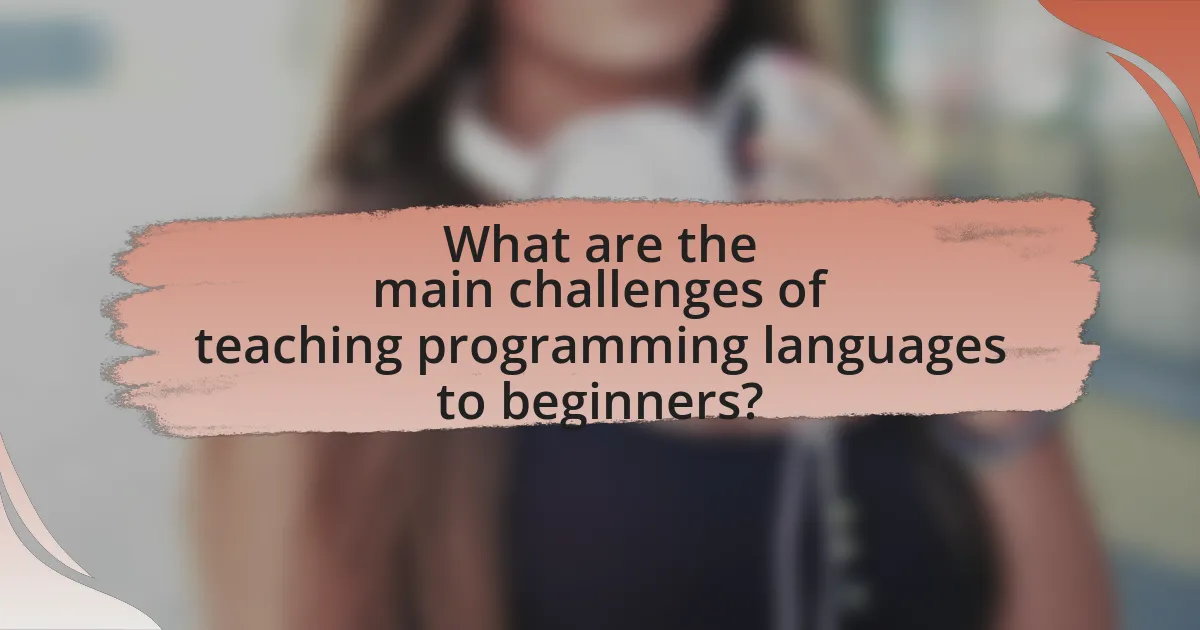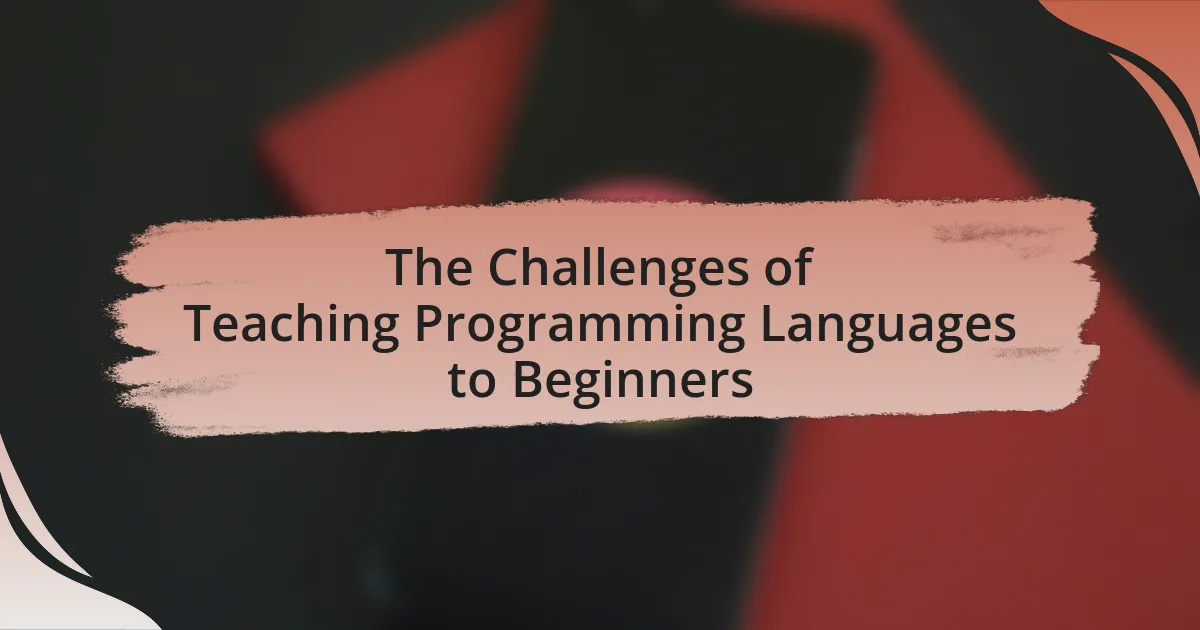The article examines the challenges of teaching programming languages to beginners, highlighting issues such as the complexity of concepts, steep learning curves, and the lack of practical application. It discusses why beginners struggle with programming, focusing on specific difficult concepts like recursion and object-oriented programming, and emphasizes the importance of prior knowledge and the choice of programming language in the learning process. Additionally, the article explores effective teaching strategies, the role of hands-on practice, and the impact of external factors on programming education, ultimately suggesting methods to enhance curriculum design and support for novice learners.

What are the main challenges of teaching programming languages to beginners?
The main challenges of teaching programming languages to beginners include the complexity of concepts, the steep learning curve, and the lack of practical application. Beginners often struggle with abstract concepts such as variables, loops, and data structures, which can be difficult to grasp without prior experience. Additionally, the learning curve can be overwhelming, as beginners may face frustration when encountering errors or debugging code. Research indicates that 70% of beginners abandon programming due to these challenges, highlighting the need for effective teaching strategies that simplify concepts and provide hands-on practice.
Why do beginners struggle with programming concepts?
Beginners struggle with programming concepts primarily due to a lack of foundational knowledge and experience. This gap often leads to difficulties in understanding abstract concepts such as algorithms, data structures, and syntax. Research indicates that cognitive overload can occur when learners are introduced to multiple new concepts simultaneously, making it challenging to grasp the material effectively. For instance, a study by John Sweller on Cognitive Load Theory highlights that excessive information can hinder learning, particularly for novices who are not yet familiar with the basic principles of programming. Additionally, beginners may face challenges in problem-solving and logical thinking, which are essential skills in programming. These factors collectively contribute to the struggles that beginners encounter when learning programming concepts.
What specific programming concepts are most difficult for beginners?
The specific programming concepts that are most difficult for beginners include recursion, object-oriented programming, and asynchronous programming. Recursion can be challenging because it requires understanding how functions can call themselves and the concept of base cases. Object-oriented programming introduces complexities such as inheritance, encapsulation, and polymorphism, which can be abstract for newcomers. Asynchronous programming complicates the flow of execution, requiring learners to grasp concepts like callbacks, promises, and event loops. Research indicates that these concepts often lead to confusion and frustration among beginners, as they require a shift in thinking from linear to more complex problem-solving approaches.
How do prior knowledge and experience affect learning programming?
Prior knowledge and experience significantly enhance the learning of programming by providing a foundational understanding of concepts and problem-solving skills. Individuals with prior exposure to programming languages or related fields, such as mathematics or logic, can more easily grasp new programming concepts, as they can relate them to what they already know. Research indicates that learners with previous experience often demonstrate improved retention and application of programming skills, as evidenced by a study published in the “Journal of Educational Computing Research,” which found that students with prior programming experience scored higher on assessments than their novice counterparts. This correlation suggests that prior knowledge and experience not only facilitate quicker learning but also foster greater confidence in tackling programming challenges.
What role does the choice of programming language play in teaching?
The choice of programming language significantly influences the effectiveness of teaching programming concepts. Different languages have varying levels of complexity, syntax, and paradigms, which can either facilitate or hinder a beginner’s understanding. For instance, languages like Python are often recommended for beginners due to their simple syntax and readability, which allows learners to focus on fundamental programming concepts rather than getting bogged down by complex syntax rules. Research by the University of California, Berkeley, indicates that students using Python in introductory courses perform better and report higher engagement levels compared to those learning more complex languages like C++ or Java. This evidence underscores the importance of selecting an appropriate programming language to enhance learning outcomes for beginners.
Which programming languages are considered beginner-friendly?
Python and JavaScript are considered beginner-friendly programming languages. Python’s simple syntax and readability make it accessible for newcomers, while JavaScript is widely used for web development, allowing beginners to see immediate results in their projects. According to a survey by Stack Overflow, Python consistently ranks as one of the most popular languages among beginners due to its ease of learning and extensive community support. Similarly, JavaScript’s versatility and integration with HTML and CSS make it an ideal choice for those starting in programming.
How does the complexity of a language impact the learning curve?
The complexity of a language significantly impacts the learning curve by influencing how quickly and effectively learners can grasp its concepts and syntax. Languages with simpler syntax and fewer rules, such as Python, tend to have a gentler learning curve, allowing beginners to focus on problem-solving rather than getting bogged down by intricate grammar. In contrast, languages with more complex syntax and extensive rules, like C++ or Java, can create steeper learning curves, as learners must navigate additional layers of abstraction and detail. Research by the National Center for Women & Information Technology indicates that programming languages with lower complexity can lead to higher retention rates and increased confidence among beginners, further validating the correlation between language complexity and the learning curve.
How do teaching methods influence beginner learning?
Teaching methods significantly influence beginner learning by shaping how effectively new concepts are understood and retained. For instance, active learning strategies, such as hands-on coding exercises and collaborative projects, have been shown to enhance comprehension and engagement among beginners in programming. Research by Freeman et al. (2014) in “Active Learning Increases Student Performance in Science, Engineering, and Mathematics” indicates that students in active learning environments perform better than those in traditional lecture-based settings. This demonstrates that the choice of teaching method directly impacts the learning outcomes for beginners, making it crucial to adopt effective pedagogical approaches in programming education.
What are the most effective teaching strategies for programming?
The most effective teaching strategies for programming include project-based learning, pair programming, and the use of interactive coding platforms. Project-based learning engages students by allowing them to work on real-world projects, which enhances their problem-solving skills and understanding of programming concepts. Pair programming fosters collaboration and communication, enabling learners to share knowledge and tackle challenges together, which has been shown to improve learning outcomes. Interactive coding platforms, such as Codecademy and LeetCode, provide immediate feedback and gamified experiences, making learning more engaging and effective. Research indicates that these strategies lead to higher retention rates and better comprehension among beginners in programming education.
How can hands-on practice enhance understanding of programming?
Hands-on practice enhances understanding of programming by allowing learners to apply theoretical concepts in real-world scenarios. Engaging in coding exercises, projects, and problem-solving tasks helps solidify knowledge, as learners can see the immediate effects of their code and troubleshoot errors in real time. Research indicates that active learning techniques, such as coding practice, lead to better retention of information and improved problem-solving skills. A study by the National Academy of Sciences found that students who engaged in hands-on programming activities performed significantly better in assessments compared to those who relied solely on lectures. This evidence supports the notion that practical experience is crucial for mastering programming concepts.

What external factors contribute to the challenges of teaching programming?
External factors that contribute to the challenges of teaching programming include the rapid evolution of technology, varying levels of student preparedness, and limited access to resources. The fast pace of technological advancement means that programming languages and tools frequently change, making it difficult for educators to keep curricula up-to-date. Additionally, students often come with different backgrounds and prior knowledge, which can create disparities in learning experiences. According to a report by the National Center for Women & Information Technology, 40% of students lack foundational skills in mathematics and logic, which are crucial for programming. Furthermore, access to computers and reliable internet can be limited in certain regions, hindering students’ ability to practice and learn effectively.
How does the learning environment affect programming education?
The learning environment significantly influences programming education by shaping students’ engagement, motivation, and overall learning outcomes. A supportive and resource-rich environment fosters collaboration and encourages experimentation, which are crucial for mastering programming concepts. Research indicates that environments that incorporate hands-on activities and peer interactions lead to higher retention rates and deeper understanding of programming languages. For instance, a study by McCracken et al. (2001) found that students in collaborative learning settings performed better in programming tasks compared to those in traditional lecture-based environments. This evidence underscores the importance of an interactive and supportive learning atmosphere in enhancing programming education for beginners.
What are the benefits of collaborative learning in programming?
Collaborative learning in programming enhances problem-solving skills and fosters a deeper understanding of concepts. When learners work together, they can share diverse perspectives, leading to innovative solutions and improved critical thinking. Research indicates that students engaged in collaborative learning environments demonstrate higher retention rates and better performance in programming tasks, as evidenced by a study published in the Journal of Educational Psychology, which found that collaborative groups outperformed individual learners in coding assessments. Additionally, collaborative learning promotes communication skills and teamwork, essential competencies in the software development industry.
How can online resources and communities support beginners?
Online resources and communities support beginners by providing accessible information, guidance, and peer support. These platforms, such as forums, online courses, and social media groups, offer tutorials, documentation, and real-time assistance, which are crucial for beginners who may struggle with complex programming concepts. For instance, websites like Codecademy and freeCodeCamp provide structured learning paths that help beginners progress at their own pace. Additionally, communities on platforms like Stack Overflow and Reddit allow beginners to ask questions and receive answers from experienced programmers, fostering a collaborative learning environment. This interaction not only enhances understanding but also builds confidence, as beginners can share their challenges and successes with others who have faced similar obstacles.
What impact do instructor skills and experience have on teaching programming?
Instructor skills and experience significantly enhance the effectiveness of teaching programming. Experienced instructors possess a deeper understanding of programming concepts, enabling them to explain complex topics more clearly and relate them to real-world applications. Research indicates that instructors with practical experience in the industry can provide insights that bridge theoretical knowledge and practical skills, which is crucial for beginners. For instance, a study published in the Journal of Computer Science Education found that students taught by instructors with substantial industry experience scored 15% higher on assessments compared to those taught by less experienced instructors. This demonstrates that the combination of skills and experience directly influences student comprehension and engagement in programming courses.
How can instructors adapt their teaching styles to meet beginner needs?
Instructors can adapt their teaching styles to meet beginner needs by employing a variety of strategies that focus on clarity, engagement, and incremental learning. For instance, using simple language and avoiding jargon helps beginners grasp fundamental concepts more easily. Research indicates that scaffolding, which involves breaking down complex topics into manageable parts, significantly enhances understanding for novice learners. Additionally, incorporating interactive elements such as hands-on coding exercises and real-time feedback fosters a more engaging learning environment, which has been shown to improve retention rates among beginners. By tailoring their approach to include these methods, instructors can effectively support the unique challenges faced by beginners in programming languages.
What training do instructors need to effectively teach programming?
Instructors need a combination of pedagogical training, programming proficiency, and familiarity with educational technologies to effectively teach programming. Pedagogical training equips instructors with teaching strategies tailored for diverse learning styles, while programming proficiency ensures they possess a deep understanding of the languages and concepts being taught. Familiarity with educational technologies, such as coding platforms and learning management systems, enhances the learning experience by providing interactive and engaging environments. Research indicates that instructors who undergo specialized training in these areas are more successful in facilitating student comprehension and retention of programming concepts.

What strategies can be implemented to overcome these challenges?
To overcome the challenges of teaching programming languages to beginners, educators can implement a variety of strategies. One effective strategy is to use project-based learning, which allows students to engage in hands-on projects that apply programming concepts in real-world scenarios. Research shows that project-based learning enhances student motivation and retention of knowledge, as evidenced by a study published in the Journal of Educational Psychology, which found that students involved in project-based learning scored significantly higher on assessments compared to those in traditional learning environments.
Another strategy is to incorporate visual programming tools, such as Scratch, which simplify coding concepts through a graphical interface. This approach has been shown to lower the entry barrier for beginners, making programming more accessible. A study by Maloney et al. (2010) in the ACM Transactions on Computing Education highlighted that students using visual programming tools demonstrated improved understanding of programming fundamentals.
Additionally, providing immediate feedback through interactive coding platforms can help beginners identify and correct errors in real-time, fostering a more effective learning experience. Platforms like Codecademy and LeetCode utilize this method, resulting in higher engagement and faster skill acquisition among learners.
Lastly, fostering a supportive community through peer collaboration and mentorship can enhance the learning experience. Research indicates that collaborative learning environments lead to better problem-solving skills and increased confidence among beginners, as noted in a study by Johnson and Johnson (2009) in the Review of Educational Research.
How can curriculum design be improved for beginner programmers?
Curriculum design for beginner programmers can be improved by incorporating project-based learning and real-world applications. This approach engages students actively, allowing them to apply theoretical concepts in practical scenarios, which enhances understanding and retention. Research indicates that project-based learning increases student motivation and achievement, as evidenced by a study published in the Journal of Educational Psychology, which found that students involved in project-based learning scored higher on assessments compared to those in traditional learning environments. Additionally, integrating collaborative learning opportunities fosters peer interaction, which has been shown to improve problem-solving skills and knowledge sharing among beginners.
What elements should be included in a beginner programming curriculum?
A beginner programming curriculum should include fundamental programming concepts, practical coding exercises, and problem-solving skills. Fundamental programming concepts encompass variables, data types, control structures, functions, and basic algorithms, which form the foundation of programming knowledge. Practical coding exercises allow students to apply these concepts in real-world scenarios, reinforcing their understanding and building confidence. Problem-solving skills are essential, as they enable beginners to approach coding challenges methodically and creatively. Research indicates that curricula incorporating hands-on projects and collaborative learning significantly enhance retention and engagement among beginners, making these elements crucial for effective teaching.
How can real-world applications be integrated into programming lessons?
Real-world applications can be integrated into programming lessons by incorporating project-based learning that aligns with industry standards. This approach allows students to work on tangible projects, such as developing a website or creating a mobile app, which mirrors actual tasks they would encounter in a professional setting. Research indicates that project-based learning enhances engagement and retention, as students can see the relevance of their skills in real-world contexts. For instance, a study by Thomas Markham in “Project Based Learning Handbook” highlights that students who engage in real-world projects demonstrate improved problem-solving skills and a deeper understanding of programming concepts.
What resources are available to assist beginners in learning programming?
Online platforms such as Codecademy, freeCodeCamp, and Coursera provide structured courses specifically designed for beginners in programming. These platforms offer interactive lessons, coding exercises, and projects that facilitate hands-on learning. For instance, Codecademy has over 300 million lessons completed, indicating its effectiveness in teaching programming concepts. Additionally, resources like books, such as “Automate the Boring Stuff with Python” by Al Sweigart, offer practical programming skills for beginners. Furthermore, community forums like Stack Overflow and Reddit’s r/learnprogramming provide support and answers to questions, enhancing the learning experience.
Which online platforms offer effective programming courses for beginners?
Online platforms that offer effective programming courses for beginners include Codecademy, Coursera, edX, and Udacity. Codecademy provides interactive coding lessons that cater specifically to beginners, covering languages like Python and JavaScript. Coursera partners with universities to offer structured courses, often including hands-on projects and peer-reviewed assignments, which enhance learning. edX also collaborates with educational institutions to deliver comprehensive programming courses, allowing learners to earn verified certificates. Udacity focuses on practical skills through its Nanodegree programs, which are designed in collaboration with industry leaders, ensuring relevance to current job markets. These platforms have been recognized for their quality and effectiveness in teaching programming fundamentals to newcomers.
How can mentorship programs enhance the learning experience for beginners?
Mentorship programs enhance the learning experience for beginners by providing personalized guidance and support tailored to individual learning needs. This one-on-one interaction allows beginners to ask questions, receive immediate feedback, and gain insights from experienced mentors, which accelerates their understanding of complex programming concepts. Research indicates that mentorship can lead to a 20% increase in retention rates among learners, as it fosters a sense of belonging and motivation. Additionally, mentors can share practical experiences and industry knowledge, bridging the gap between theoretical learning and real-world application, which is crucial in programming education.
What best practices can educators adopt to support beginner programmers?
Educators can adopt several best practices to support beginner programmers, including providing clear, structured learning paths and incorporating hands-on, project-based learning. Clear learning paths help students understand the progression of concepts, while project-based learning engages them in practical applications of their skills, reinforcing theoretical knowledge. Research indicates that students retain information better when they apply it in real-world scenarios, as shown in studies by the National Research Council, which emphasize the importance of active learning in programming education. Additionally, offering regular feedback and fostering a supportive community can enhance motivation and confidence among beginners, further aiding their learning process.
How can feedback and assessment be structured to benefit beginners?
Feedback and assessment can be structured to benefit beginners by providing timely, specific, and constructive input that focuses on their progress and areas for improvement. This approach allows beginners to understand their strengths and weaknesses, facilitating targeted learning. For instance, formative assessments, such as quizzes and coding exercises, can be used to gauge understanding and provide immediate feedback, which has been shown to enhance learning outcomes (Black & Wiliam, 1998). Additionally, incorporating peer reviews encourages collaboration and diverse perspectives, further enriching the learning experience. By utilizing these methods, educators can create a supportive environment that fosters growth and confidence in beginners learning programming languages.
What are some common pitfalls to avoid when teaching programming to beginners?
Common pitfalls to avoid when teaching programming to beginners include overwhelming them with complex concepts too early, failing to provide practical examples, and neglecting to encourage problem-solving skills. Overloading beginners with advanced topics can lead to confusion and frustration, as studies show that learners benefit from a gradual introduction to programming concepts. Providing relatable, real-world examples helps solidify understanding, as evidenced by research indicating that contextual learning enhances retention. Additionally, fostering problem-solving abilities is crucial; a lack of emphasis on this skill can hinder a beginner’s ability to apply what they learn, which is supported by findings that highlight the importance of critical thinking in programming education.

Leave a Reply